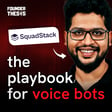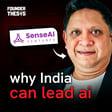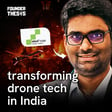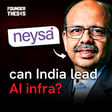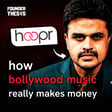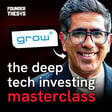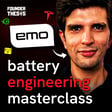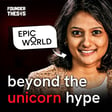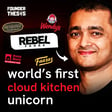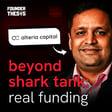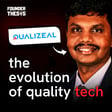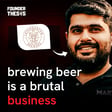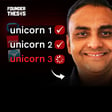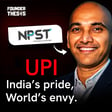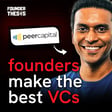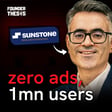Become a Creator today!Start creating today - Share your story with the world!
Start for free
00:00:00
00:00:01

Making fashion brands agile | Pawan Gupta @ Fashinza
Fashinza is an apparel-tech startup solving to reduce the time it takes to release a purchase order in the apparel and fashion space. Pawan is a serial entrepreneur whose first startup in health- tech was acquired. With Fashinza, he plans to revolutionise the apparel manufacturing industry by leveraging new-age technologies.
Read the text version of the episode here.
Read more about Fashinza:-
1.Fashinza: Using technology to empower SME apparel manufacturers
2.Powering sustainable fashion and driving efficiencies with technology
5. Fashion supply chain startup fashinza gets $30m from mars growth capital, liquidity group
Transcript
Introduction to Pavan Gupta and Fashionza
00:00:00
Speaker
Hi, everyone. I'm Pavan Gupta, co-founder and CEO of Fashionza.
00:00:16
Speaker
As an entrepreneur, you are essentially building a solution to a problem. Hopefully, a problem that has a large addressable market and a truly seasoned entrepreneur would be able to define the problem in a single simple sentence. Bhavan Gupta is the founder of Fashionza, an April tech startup that has raised more than $100 million in debt and equity till date.
00:00:36
Speaker
He is a serial entrepreneur whose first venture in the health tech space got acquired. And the problem he is solving at Fashion's up boils down to a single metric. He wants to reduce the time it takes to release a purchase order in the apparel and fashion space. This might seem like a trivial problem, but it's a problem that affects billions of dollars of revenue and can potentially lead to massive competitive and profitability advantages.
Fashionza's Competitive Edge in Supply Chain
00:00:59
Speaker
And the key to winning against a fashion retailer like Sheen is to actually solve this problem and bring the numb. Stay tuned for this insightful episode of the Founder Thesis Podcast. And don't forget to subscribe to us on any audio streaming app for more such conversation with founders.
00:01:25
Speaker
Before we talk about the path which got you to where you are today, help me understand for a listener, why does Fashionsa matter? Like, why should I care to know more about Fashionsa? Absolutely. So Fashionsa was one of the first B2B startups for promoting apparel manufacturing.
00:01:43
Speaker
making it easier. Today, we work with close to 100 global primes, including the likes of Inditex. And at the same time, we work with over 120 factories across India, Bangladesh, Turkey. So it's a big business now. And we do over $100 billion of business a year. I would say we were one of the first startups in B2B in India who actually started a cross-border trade.
00:02:08
Speaker
And now we obviously have a flood of them. We've been pioneers at a lot of these things. Yes, there were a couple of B2B startups before us, but I think CrossFit was new for us. Apparel was absolutely new that we started. I believe you've raised something like $110-115 million just in the last two odd years.
00:02:29
Speaker
We raised a lot of money. We don't say that we are just proud of the fact that we raised a lot of money, but I think there's a kind of partners that we have on board, including like Westbridge, Naspers, Accel, Elevation, EDQ. I think these are some of the best names out there, best people out there. So we're really proud of our cap table.
00:02:49
Speaker
Okay. Amazing. I mean, arguably, like we like to say that we have the best capital at our stage in the market. But again, that's always arguable. Tell me about the path which got you here. Now you're a serial entrepreneur. What was the trigger to get into entrepreneurship?
Pavan Gupta's Entrepreneurial Journey
00:03:03
Speaker
I think I don't really like the term serial entrepreneur. Even the first startup that we started, I didn't intend to sell it. And it's a long story. But the idea was always to build a company that lasts for generations.
00:03:17
Speaker
I also believe that as companies become more and more mature, as founders become more and more mature, that is when you start getting the real and the large impact. So it takes time to build a company. So anyways, I think, yes, this is my second startup. Previously, we started back in 2014, two years out of college, graduated from IT there in 2012, worked for a couple of years just to save up enough money to be able to leave my job and start up.
00:03:46
Speaker
What made you so sure that you wanted to start up? Was it the IIT Delhi ecosystem? I think like 2012 as achieving the IIT Delhi ecosystem was probably the best out there but it still was not like entrepreneurship was never a mainstream thing. QYI was difficult at Batana but somehow something comes from my upbringing. So I grew up in a very small town called Hissar.
00:04:10
Speaker
Either they have a government job or they have their own manufacturing or business. That's it.
00:04:22
Speaker
So, that is how we grew up. And I think obviously, your upbringing shapes up a lot of things. Government jobs are considered safe. Reputation-wise, there was a great reputation in the market. People respected you. Or you were a businessman. Obviously, you had great respect. But at the same time, you were also rich.
00:04:43
Speaker
So I always grew up assuming that businessmen are supposed to be rich. Hence, if you wanted to become rich again, all of us who grew middle class, lower middle class, always wanted to become rich. We wanted to have those comfort supplies. Was your dad in a government job? No, my dad was actually interested in a private job.
00:05:03
Speaker
So my dad used to manage a plant, a factory. He didn't own it, but he used to manage it. So everybody would always think that my dad owns that factory because that is the natural thing to be. So in any case, I think like I got into college, obviously big dreams, but the thing was key either. And so I wanted to have my own thing as simple as that. And that is where I felt that I could do, go big.
00:05:30
Speaker
go fast. And within a job environment, I would just be stuck with natural progression of growth that you can achieve in a job. Obviously, things have changed a lot since then. I think you can obviously join a startup and grow very fast as well. But those were the days when from IIT consulting finance, or some of the core tech jobs used to be the most important jobs, which essentially gave you a good career.
00:05:56
Speaker
But I always felt that that would be very limiting for me and hence I wanted to start up. So that is how I ended up. Within the fourth year itself, the final day of the college, I decided that I wanted to start up and started planning around what could be ideas, what could be the sectors. Fortunately, met a couple of my really close friends. We knew each other for a very long time and ended up deciding that it's a great idea to just start up together. But again, we did not have any money.
00:06:25
Speaker
So we decided, let's work for a couple of years. Let's keep our dream alive. Let's start building on the side. And then when we have just about enough money to sustain ourselves for a year or 18 months without a job, that is when we'll go ahead and start. The funding environment, I don't want to say at that time, was not that strong, which meant that we did not know how to raise funds. We were not confident of raising funds. But we were confident that what we wanted to build in health care would be extremely valuable.
00:06:54
Speaker
And hence we just wanted to go for it. So that is how we left our job. How did the healthcare come as the idea you wanted to build in? I think when we decided that we wanted to build something, we thought that we would enjoy building somewhere where there would be a possibility of a big impact.
00:07:12
Speaker
not just in terms of how big the company you can make, but at the same time, if you can really impact the lives of your customers or the people in general. Help turned out to be one thing we got excited. It obviously helped that one of our co-founders, parents for doctors, so we could get early insights from them. We could also get really good feedback from them very quickly and get connected to the market.
00:07:36
Speaker
You had Nipun as your co-founder. I've interviewed Nipun also in the past. Nipun was one of my co-founders. We were actually dorm mates for almost four years and then Mudith was the other co-founder. So what was the idea that you wanted to build on? Tell me about that journey. So we started building in medical tourism.
00:08:00
Speaker
We were very interested about how medical tourists would come to India to get treatment, and especially from lower income countries where the facilities were not available, which was very insightful. We are very used to think that it's only the people from the US and UK who would come here because of the cheap cost of treatment, but eventually that turned out to be people from Afghanistan, Sudan, Iraq, but Bangladesh were coming here to get treatments.
00:08:26
Speaker
And we thought that maybe we can make their lives easier by getting them really good treatment at good prices. So that is how we started building on it. Then one thing led to the other. This was like monetized through a margin from customer or through a margin from hospitals? Margin from hospitals. They would give you like a referral fees for bringing them business. Pretty much, yeah. So that was the business model. We did that for almost like close to six months or so.
00:08:55
Speaker
But one thing led to the other. Were you making enough money? Yeah, so this was for you to want to keep doing. Yeah, so money was not bad actually in this. And I think the customers also loved us. The doctors loved us. It is just that I think we kept on questioning why are we building a commission-led model or why are we building a middleman here? Especially early young techies, we started thinking whether there is a technology solution here.
00:09:24
Speaker
which means that we don't have to do any operations or anything. We just like are able to connect them together and from there they can take it. I mean, to be honest, it was not the right decision at that time, but also tried it out with no real success. That is when we got an insight that one of the key things is actually, if you look at the domestic market, a doctor to doctor referral actually is big, especially from small town to big towns.
00:09:54
Speaker
And we thought that, OK, let's forget Pinternational for now. Let's just focus on domestic.
Curify: Healthcare to Acquisition
00:10:01
Speaker
And in domestic, such a thing operates less on, let's say, a customer reaching out to a solution, but more a doctor suggesting another doctor. And that is how having one thing led to the other. And we started building a doctor's network, more like a LinkedIn for doctors. And hence, Curify was born. I mean, why aren't you running Curify today?
00:10:23
Speaker
because LinkedIn for doctors as a business idea has merit. I believe there's a company in the US which went public a year or two back. I believe they had like a two digit billion valuation kind of a thing. I mean, there is merit in that idea. Why aren't you running that idea today? What happened?
00:10:40
Speaker
Absolutely. I believe it's a great idea. Doximity is the name of the company that you're referring to. They do close to almost $400 billion. They are a few different businesses. They have raised less than $100 million, if I'm not wrong, to build that level of company. There's a seed around about a million and a half.
00:11:02
Speaker
And I think at that point of time, we got a strategic investor on board. How did you manage to raise? You were clueless about fundraise. How did you crack that problem? So we reached a very small angel round initially, about close to $100,000 at that time, $150,000. That got us some really good angels on board.
00:11:21
Speaker
So, all those angels came through some network of IT earlier, network of from friends and family. And those were the people who were ex-entrepreneurs, who had built their own businesses like Rajul, who now runs his own new capital, who was the founder of Pined Apps and Globalogic, Alok Mitra, India, Kushina, et cetera. So, all of these people came through one place or the other, again, with very small checks, which is a very small round.
00:11:47
Speaker
just the fact that those people were our sounding boards really helped us navigate the future ecosystem. Again, having said that, it was India back in 2014-15. Everybody was just investing in hyper-local, e-commerce, places like that. Very few investors understood core technology plays, let alone a vertical social network.
00:12:12
Speaker
So, it was not easy. People would question us on time, people would question us on whether doctors would need something like this, whether doctors would adopt technology. So, it was not easy. And I think that is why, as part of the cedron, we just slightly got frustrated and we got a strategic investor on board who understood healthcare market, and most importantly, they wanted to build in Indian healthcare for a very long time.
00:12:37
Speaker
And hence, we received money from them, where we got a partner who understood healthcare. This is which company which came in as a strategic investor? Round glass partner. Okay. But I mean, like, I mean, obviously getting a strategic investor on board also comes with a flip side. Eventually, you can't run a company absolutely independently, because they invested in the company, assuming that they are a strategic investor, or they have to go and acquire the company in the future or integrate that company within their own ecosystem.
00:13:07
Speaker
which meant that we could not take independent calls on running the company or raising more funds. Hence, we reached an amicable solution wherein they acquired the company at an all-cash deal, gave us a great exit, and we exited.
00:13:23
Speaker
So we sold them in 2017. We stayed with them for two more years. That's part of the lock-in and really getting the complete transition. Great thing is the company is still running very well. You know, building a social network is incredibly hard. How did you actually get enough number of users to sign up? Absolutely. I think building a social network is probably one of the toughest things out there.
00:13:48
Speaker
It is not the same as, let's say, any other operations based startup or even e-commerce, to be honest, because the value on social network only exists when you have a large portion of your time on the platform. Until then, it is just a promise because somebody else can just come up, get a large number of users and just capture you to kill you. Hardcore winner takes all dynamics exist in this social networks.
00:14:18
Speaker
So it did help that we were focused on a niche vertical rather than let's say something like a TikTok. So it did help. We did not have a lot of competition. We did not have five other startups trying to do the same thing. Yes, once we started,
00:14:36
Speaker
a couple of them more pivoted or came into our thing, but again, not too much of a competition, honestly. So we could build at our own pace. We could really work with the users, build out right solutions, right features for them, and take our own time, which I would say was a great help. For example, for the first 12 months or so from the time we started, I think we had pretty much nothing.
00:15:07
Speaker
I don't think even a thousand doctors were using the platform at that time. But we went from a thousand to a hundred thousand within a matter of six months. We could take out that time to build out the right solution just to the hundred to thousand users, which would be beneficial for the next hundred thousand users. So like you invested in product market fit first before investing in growth.
00:15:33
Speaker
Correct. So we invested in two things. I think one is product market fit. Obviously, that was the key. And second, we also invested a lot in just building single person utility tools. A social network will only give you meaning or value when a critical mass of people start using the platform, especially if it is user generated content, UGC. This is what we defined as single person utility. That I don't need you to be there on the platform. I can just open the platform and get some value out of it.
00:16:04
Speaker
For example, in our case, CuraFire, we just built a news platform. Very hardcore, academic, medical news, what's happening combined with some medical jokes, humor, or some really relevant news articles like some violence against doctors and things like that.
00:16:24
Speaker
Now, this was all curated by a content team sitting in house. Every day, we would give you 10 pieces of great news. So you could just come on the platform, read the news, even though there are 5,000 other users are not using it, but still you're getting some value or effect. So that's a good way to hack your initial set of growth.
00:16:44
Speaker
You invested in content as a way to build early engagement until you reached that minimum viable level of network where UGC kicked in. Basically, you hacked the UGC by first doing in-house content generation until the UGC came in. Absolutely correct. Amazing. For this 1,000 to 100,000 journey, did you also spend on paid marketing to attract users, or was it all viral? So we did do some paid marketing.
00:17:12
Speaker
But to be honest, I think paid marketing did not work very well for us. It was very hard to really target doctors on a social network like Facebook, although we did try a bunch of things there. But I think most of it which was something like some growth hacks. For example, we use Gorilla SMS marketing, or we would do, let's say, paid marketing, but very focused on
00:17:36
Speaker
So let's say, for example, a pediatric conference was going on in Delhi. So we would geofence the area to exact that hotel where that conference was going on, assume that everyone there is a doctor, and then do paid marketing. And that resulted in very low cost, but at the same time, really high relevance. What do you mean by Gorilla SMS marketing? So Gorilla SMS isn't like when we would ask our doctors to invite other doctors, as simple as that.
00:18:03
Speaker
But then we would just use SMS as a tool for that invite. Let's say you are getting a message that, hey, Dr. Akshay, Dr. Pawan and Dr. Neha are inviting you to join Curify. And those Dr. Neha and Dr. Pawan are, let's say, in your contact work. They're super relevant to you.
00:18:24
Speaker
And suddenly you're like, Oh, great. Okay. Those two people are inviting me, then maybe it is something let's check it out. Right. Which is similar to what LinkedIn does. Like it takes your contact, it imports your contact book and sends emails. Okay. Well, I'm just saying that some of these things might feel intrusive at that point of time, but we're talking about back in 2015, 2016, when this used to be the norm.
00:18:49
Speaker
Importing email contacts is still the norm, I think. Anyone who signs up for LinkedIn, LinkedIn kind of prompts them to do that. Had you figured out monetization by the time you got acquired? We had figured out monetization. We were forced to figure out monetization because we didn't have a crazy amount of money.
00:19:09
Speaker
We were very frugal and then we started monetization just because we felt a need to boost our revenues. We didn't want to delay everything on the funding and then we started building a monetization layer on top of it using pharmaceutical companies, medical devices companies to further
00:19:29
Speaker
using Curify as a reach out platform, which in early days, or even today, they use MRs or their on-ground representatives to do that reach out to the doctors. And this is with position Curify as a platform where they could reach out to those doctors in a very targeted manner. You could even target somebody like a pediatric oncologist, which is probably like only 20 exist in India.
00:19:58
Speaker
give them absolutely relevant stuff. So more advertorials, less ads, less marketing, which is beneficial for both, obviously the company, but at the same time, the doctor as well. That worked beautifully. I think like doctors loved it. Advertisers loved it. They were getting amazing reach. The MRs, when they were visiting those doctors were saying that, oh, I have already read this content on Curify telling me something new.
00:20:26
Speaker
And I think that just absolutely blew it. I mean, honestly, before we got acquired, we could see that if we stayed at it for three, four more years, we could easily build like a 10, $20 million a year around business in the next three years. Yeah, because pharma marketing is a massive market, right? Billions of dollars globally. So that opportunity is there. Absolutely. And there's no platform for them to do it.
00:20:50
Speaker
Yeah. Why did you choose to get acquired if you had monetization happening? Was your runway ending or was it that Roundglass had such a big stake that you could not say no?
00:21:02
Speaker
It's a combination of things. I think one is obviously just the fact that we had a strategic investor on board. So sooner or later, that was the thing that we would need to get acquired with them or be part of it or be integrated into the ecosystem. Just that I think we wanted to stay independent, but I think it was
00:21:23
Speaker
We felt that I think after talking to our investors as well, that a long-term independent thing might not be feasible. Hence, we started those discussions about acquisition. That, I would say, was the major goal. Post, we had figured out monetization. Post, we had figured out that engagement. Funding was not that big of a challenge. I think we were getting funds from elsewhere as well.
00:21:44
Speaker
I'm guessing a lot of people would be scared to invest because you already had a strategic investor that might have also closed some doors for you. Interestingly, no. I think even for future investment, I think people just wanted to see that, OK, just make sure that you guys are independently running the company. OK. So what were your learnings from Curify before we come to how Fascians got started?
00:22:13
Speaker
a few things. And I tell you all the things that went well, as well as some of the things that we learned and then did differently. I think number one thing we realized that I think getting great people on board, honestly, a lot of times means just like getting really enthusiastic people on board, getting them young. And they can just surprise you if you give them autonomy.
00:22:39
Speaker
Obviously, the average age in Fashionsa is much more than curifying. A couple of reasons, obviously, we were 23 when we started. I was 29, so that does play a part. And the second, obviously, because we've raised more money, we are able to afford more expensive and experienced people.
00:22:57
Speaker
but it is still much less than, let's say, people in the industry. I think the average age is still not above 28, 29, even though the average age in Q5 was something like 23 or 24. But again, having said that, I think just getting young people on board, giving them autonomy and giving them resources
00:23:19
Speaker
Not unlimited, but very limited resources can really force them to find innovative solutions. For example, if we had a million dollars digital marketing budget, I'm pretty sure we would not be thinking of all these solutions of GFS, around conferences, doing good in SMS marketing, et cetera. We would still be just doing what everyone else was doing. Strain break.
00:23:41
Speaker
I think this is what happens when you raise a lot of money. So being resource constrained was obviously challenging, but at the same time, it drove amazing innovation. I think that was amazing learning. Second important thing was just taking your time and building out of the company. Companies take time to build.
00:23:59
Speaker
you can't hack your way to a billion dollar company in two years. If it was so easy to build a billion dollar company in two years in your industry, then either you will get disrupted that easily as well, or you just haven't figured out the product market side, you have just become big. Amazing, amazing insights. Okay.
Building a Mission-Driven Team
00:24:17
Speaker
The hiring and the culture piece that you discovered at Curify, did that lead to some principles that this is how you think about hiring now and this is how you think about culture building? Curify was honestly slightly easier because we were all very young people and we were always resource constraints, so our hiring was very slow.
00:24:39
Speaker
But what we realized was that when our hiring was slow, and we were hiring people for their mission, their potential, and less about their experience, we were hiring people who were amazingly cultural victims. We would just love each other's company.
00:24:57
Speaker
I think we were at its peak 45 people in CuraFI and those 45 people even today are good friends with each other. I think I still end up meeting CuraFI people every week. So I think just hiring people who you love to enjoy and spend time with.
00:25:14
Speaker
does amazing, it does wonderful effects to your company because people want to spend more time on problem solving. People love each other's company and hence they want to work with each other. And they're also generally end up becoming more, they feel that anything that they want to do becomes less of a risk because their friends are also doing this.
00:25:35
Speaker
That kind of culture is invaluable and very hard to build in companies where the hiring goes very fast. I think every single person at Curify was hired by at least one of the founders. It becomes difficult as you skin up, like at fashion, I can't say the same.
00:25:54
Speaker
But just the fact that we've hired the first 30, 40 people completely ourselves. And then those 30, 40 people have gone out to hire the people further. You can't have the same level of camaraderie as let's say at a 40 people company and a 200 people company. But I would still say that I think the level of bonding that you find here would be
00:26:16
Speaker
amazing compared to anywhere else you would find at a similar scale. And I think this is the feedback that we get from people here rather than it's just me telling you. Okay. Amazing. Amazing. So let's talk about the fashion's journey. So you got acquired and then you spent two years in the business. I'm sure during those two years, you must have also been thinking about what next. So, you know, tell me that journey of figuring out what you wanted to do next. Sure.
00:26:41
Speaker
I think obviously some time was taken out to just breathe and relax and get my head in order. Purify was an exhilarating journey, so it takes a long time to get out of that subtle mode and just be relaxed. But at the same time, I think I also didn't want to relax too much. I just wanted to go straight into the game again.
00:27:01
Speaker
For me, the most important part was less about idea, but more about finding the right person I want to start with. I was certain that I didn't want to start alone. A lot of second-time entrepreneurs we've seen start up alone, the single founder, and then go about building their own team. But I was very clear that it's a long journey. I'm probably going to spend the next 10, 15 years of my life on this.
00:27:25
Speaker
so I didn't want to do it alone and just wanted to have somebody I can trust as I would trust myself. I would say the 18 months journey from starting thinking about starting up again to actually starting up again
00:27:42
Speaker
Out of that 18 months, I think about 12 to 15 months was spent just figuring out the right coupon. And I was sure that I didn't want to start up with something I haven't known for a long time. So my search was, well, I get narrowed down to a small group of people who wanted to start up and I have known for a long time.
00:28:00
Speaker
I mean, ultimately it was landed with Abhishek and Jamal, but the idea was that for me, the idea matters less and more of the co-founder matters more. Figuring out the co-founder, narrowing it down, it was more about getting some idea where we had some edge where we were absolutely passionate about. We were not just doing it for money, but at least we were solving a large global problem.
00:28:27
Speaker
So not a small problem, not a local problem, but a large global problem so that the company could continue to grow for 20, 30, 40 years, no matter what. Obviously, there'll be more disruption, there'll be more innovation, technology, which will keep on coming in.
00:28:44
Speaker
inspiration is large, the market that you're playing in is large, and if the problem segment, the problem that you're solving is absolutely massive, then you'll keep on changing yourself, de-winding yourself to continue to keep building. So again, it comes down to the same thing that I wanted to build a company which lasts for generations.
00:29:04
Speaker
and not just an opportunistic play. That is there. And I think like, again, if you remember my earlier point that what I knew growing up was government jobs and manufacturing ended up spending a lot of time at home post acquisition and
00:29:19
Speaker
got really excited about how my friends, how my dad was still working in that plant and how all of my friends were manufacturing one thing or the other. And that engineering mindset kicked in and that it's just lovely to see stop getting manufactured in factories.
Navigating the Fashion Industry
00:29:37
Speaker
Right. Is Hissar like a hub for textiles or fashion or something like that? No, no. It's not a fashion or textile hub, but it's a manufacturing hub. So people like Jindal come from Hissar. It's a very large manufacturing hub, but it was never a textile or fashion hub. So I wanted to do something in manufacturing. I was very excited about it, but wanted to pick up an industry where India had already an edge.
00:30:07
Speaker
And at the same time, the industry was also very dynamic. Abhishek comes from a more fashion e-commerce background. So before Curify, he was at Line Road and before that at Flipkart. So he had seen a bunch of fashion e-commerce. So that is how we started wondering about manufacturing in the textile and apparel space.
00:30:27
Speaker
So that's how we ended up with the idea that we could actually solve manufacturing in a parallel, amazing industry. Because of e-commerce, because of fast fashion, because of people like Xian, the industry was completely reinventing itself. So now imagine a trillion dollar fashion industry, a global industry with supply chains having been created over hundreds of years, completely reinventing itself,
00:30:55
Speaker
forced by the consumer demand, forced by social media's ability to portray your fashion in real time. And now you have an opportunity of a lifetime.
00:31:09
Speaker
like the entire trillion dollars of supply chains are going to get reorganized, and then you put in China plus one, you put in industries moving out of China due to labor wage, then COVID came in, which meant that our supply chain need to be further reorganized. And we just found an amazing opportunity to go out there, build amazing solutions, which people would love to be a part of.
00:31:35
Speaker
I think essentially the fast fashion trend is what was driving this change in the supply chain. You could no longer talk about your line, which you will release after six months on a fashion show. But if someone saw something on TikTok, they would want to buy it the next day. So that whole fast fashion movement meant that the supply chain had to get compressed to deliver things faster. So that was the opportunity which you saw.
00:32:01
Speaker
Absolutely. And I think more obviously that was getting created, but I think what we also really believed is that this is also a better way of running a business. We saw people or brands just like building up inventory for the entire six months, 12 months in advance, betting on the train that is going to be there in that season. And what people were realizing that half of their inventory was not really it shouldn't have been made.
00:32:30
Speaker
Either they were selling it at discount or it was not selling and they were just putting it at clearance sales or just like liquidating stuff. From a first principle perspective, if we could not build up that inventory, if we could just be closer to the season, if we could just react instead of forecast, we could solve most of these things.
00:32:56
Speaker
I mean, why would you want to build something about 30% of which is just going in clearance or liquidation? So January 2020, you started Fascenza. What was the idea? Did you want to do a Shane model where you're directly selling to consumers? What was the plan there? Our plan was very simple. I think we wanted to make manufacturing easy, agile, and quick. And we started by meeting the manufacturing area.
00:33:27
Speaker
as simple as that. Now, by easy we went that, okay, let's just say it's an online platform. You can get place your orders easily. You can find factories. You can track your entire production because it's a long lead time thing. And at least just not be continuously worrying about where the next shipment is going to come from.
00:33:48
Speaker
So we said that, okay, let's just take this at once. This you're saying for the buyer, like somebody who's buying from factories, you built a platform for them to allow the information to flow real time.
00:34:00
Speaker
I mean, honestly, like we wanted to, so we were the ones ensuring manufacturing. So it was not just a technology platform. We were a full stack solution from day one. So we wanted to build that commerce module from day one itself. So initially we were just a commerce platform where you could get your products manufactured. So just making that easy and transparent. How did you crack your first account? The first buyer? Yeah. So we cracked the first account, I mean, majorly through our network.
00:34:30
Speaker
And I think we knew a bunch of people who are running their own brands, people like Soulstore, Fab ID, et cetera. And we knew them for some time. So the D2C fashion brands. The D2C fashion brands. Most of these brands were also very interested in just like going there and doing very... They didn't want to solve manufacturing, let's say.
00:34:54
Speaker
Their idea was that they wanted a software customer. They were solving the branding. Correct. Exactly. What was your proposition to them? They could upload the design, and then you would get it manufactured. How do you receive an order? Absolutely. And in general, in the fashion world, how does one receive an order? Today, if I don't talk about how the industry works, it's a lot of phone calls, a lot of emails, a lot of visits, physical visits.
00:35:23
Speaker
When you do all the sampling for months and months, you do the look and feel test. You would think, OK, I want to have this some sort of floral print shirt. Here is the photograph of what I want. Can you do something and send me some samples? So again, all these things we take, we send in. People would be like, oh, this is slightly hard. Can you make it softer? So it's a lot of trial and error.
00:35:52
Speaker
And hence, it ends up taking a lot of months for anything to get sorted. You're saying getting the purchase order itself is like a task of a couple of months. Oh, easy. More than that. Wow. OK. In the online industry, I think it takes about six months to get a purchase order. OK. And so tell me what you did. So we started slightly, slightly different. So we said that, OK, let's we already have a set supply chain. But we have, since we have almost, when we started, we had probably 15, 20 factories on board here.
00:36:21
Speaker
will figure out the exact things that these factories can do. And your deal with the factory was that you dedicate some of your line to me, like some part of your manufacturing capacity will be dedicated to me, like something like that. So we consciously onboarded those factories who already had that spare capacity available due to other utilization.
00:36:40
Speaker
So we did not have to make any commitments to them. It is just an additional business that we are bringing to them. So now because the lines are available, our idea was that let's understand what these factories are really capable of. So these factories, let's say for example, if I'm talking about a t-shirt with sold store. Now we only get a factory which has done something like this in the very similar product, very similar price points, similar quality levels, similar brands.
00:37:08
Speaker
we essentially turned that trial and error problem into a data problem. The first thing that we grabbed was this matching. Let's get a large network of factories where we can match the exact requirement with somebody who has the experience of working in the past.
00:37:24
Speaker
So that reduces the scope for errors by a lot. Okay. Did you solve this matching by having like ready to order products listed, like creating a catalog? Like was that the way you did it? Like you created a catalog and then no, it was still custom made. We were never a catalog company. It was everything was always custom made because we were working with brands. But I think the idea was like understanding what the factory is doing in the past to get more data on them.
00:37:54
Speaker
That was the entire idea. But how did this help you cut the time, like that six-month time to get a PO, a purchase order? Yeah. I think what it does is that, let's say, when somebody like a soldier comes to us and says, okay, I want to get these 20 designs manufactured, and these are the kind of t-shirts that we want, these are kind of fabrics, etc.
00:38:14
Speaker
Then we exactly know that this factory has done this fabric in the past. And they have done similar prints in the past. So that means that we just need to tell them, OK, the fabric that you have to use is, let's say, the fabric A that you used in that previous order. And the type of print that you need to do is a print that you did on the order number 5 in the past, which means that the factories are not. So that entire point of just a look and feel, touching stuff, et cetera, becomes
00:38:41
Speaker
very quick. So now when you receive a fabric as a brand, you suddenly say, okay, this is the exact family that we wanted. Okay. So what you're saying is that the prototyping problem exists, because if you go to as a buyer, if you go to one factory, that factory may or may not understand what you need in the first go. But as a buyer, if you come to a platform, that platform will
00:39:05
Speaker
have access to multiple factories and then choose a factory which can create the right prototype in the first attempt itself. So therefore that multiple iterations of prototyping get cut down at the first prototype itself ends up getting approved by the client. Absolutely. Okay. That becomes a critical thing. Yeah.
00:39:23
Speaker
So once the prototype is logged, then the job becomes, half of the job is done. Right. Absolutely. Because then you're clear. I mean, then you can document exactly what is needed in this fabric. This is what, and you know, you can measure stuff like whatever there must be some yarn count and stuff like that for that. And so, so everything can then be like computer readable, which can allow you for better quality control at a later date. Yeah.
00:39:48
Speaker
I think what we realized in manufacturing, and Elon Musk tweets a lot about this, is that manufacturing is a lot of art and is a lot of experience. As techies and software developers, we have programmed to think on variables and their values. But the reality is that
00:40:10
Speaker
in manufacturing, the number of variables that can impact your production is absolutely like, for example,
00:40:18
Speaker
Yes, your yarn thread count and your quality or the construction of the fabric could all be same. But let's say if they are manufactured in different mills, which are situated in different cities of the country and hence the temperatures are different, their flexibility might vary. I mean, you can't program it in your computers. And hence, I think manufacturing is tough. And hence it comes with a lot of experience.
00:40:46
Speaker
So that is why you would see so many JVs entering in manufacturing, wherein somebody comes with an experience of manufacturing that product in the past. And this is something that took us some time to really appreciate and understand coming from more software background. But I mean, this was very exciting when we understood this. And hence, we started valuing the experience these factories had of manufacturing. And hence, I said that, OK, if somebody has manufactured the same product in the past,
00:41:16
Speaker
At least they can replicate the same product because they would know where to source the raw material from, what to order to that mill so that they deliver the same thing, which printing unit they need to go and tell them what to get the same print done because most of it is not about variables. Most of it is just about reducing the number of variables by doing the same thing again.
00:41:39
Speaker
OK, OK, fascinating. Can you give me examples of some mistakes you must have made in those early orders? You must have screwed up some of the orders, and what you learned from them, and how that helped you find product market fit? Oh, yeah, I think the mission mistake that we did was just assuming that if I have given the exact variables, then I should get the same product. For example, if I am giving the order for 100 grand under GSM, 100 billion cotton t-shirt,
00:42:10
Speaker
And there's no reason I'm not getting the same product that I wanted.
00:42:14
Speaker
When we started understanding, there are five more variables. There's a yarn count, there's a construction type. Then we started understanding which mail is also important. Then there's a VF fabric, there's some other fabric. All of these things started becoming important. And the last thing was just like if somebody has been manufacturing a hundred rupees t-shirt and suddenly if you give them the order for 500 rupees t-shirt, they can't switch their mindset overnight.
00:42:45
Speaker
The quality control requirement for 100 rupees versus a 500 rupees t-shirt is very different. So you can't change the factories overnight. So you have to play on their experience.
00:42:55
Speaker
Okay, amazing. When did you feel that you have reached some sort of product market fit?
Adapting and Scaling During COVID-19
00:43:02
Speaker
You know, like say in Curify, you spent almost a year with just 1000 users until you were satisfied and then you pressed the pedal on growth. Tell me about like, what would be like a comparable journey here? So in our case, I think it was slightly different from how we ran Curify. Obviously, a lot of this was due to
00:43:21
Speaker
to do with because we started in January 2020 and suddenly COVID hit. So we were pretty much a remote company for a very long time. Almost all of our hiring was done remotely. We set up a team remotely. We set up supply chains remotely. So that was tough. But I'm guessing during lockdown, even manufacturing would have shut down, right? No, so that was interesting. I think they did shut down for the lockdown period, but then they opened up very quickly first to manufacture PPs and masks, which we did in huge numbers.
00:43:51
Speaker
Yeah and then obviously the government realized that you can't shut manufacturing down. There's a huge employment at stake and these guys can't do their work from home. So manufacturing opened much quickly compared to other industries and at the same time e-commerce boom. So everybody was purchasing stuff online. There was a lot of revenge shopping.
00:44:14
Speaker
Okay, so this actually worked out perfectly for you. I'm assuming that initial downtime would have helped you build up your systems processes, hire the right folks, so that when the boom came after that downtime, you were prepared for it. Yeah.
00:44:31
Speaker
So I think that is how we started preparing for all of these things. But most importantly, I think it also meant that we were forced to build a company in a very different manner than we were used to. We were used to running a company like a family sitting in the same room, running the business like a family.
00:44:51
Speaker
I think that moved to Zoom, which is just not the same thing. Interestingly, I think that is one of the reasons we were one of the first companies to completely move back to workroom office after the lockdowns got over. But that is the thing, and I think we were also inundated with huge demand.
00:45:11
Speaker
because everybody was struggling to find a supply chain that worked during those times. So we scaled up really quickly during 2020 and early 2021. Absolutely, very, very quickly. And that did mean that multiple things broke. That did mean that we were not ready to handle that level of volume. Obviously, it was very exciting that we got so much demand, which we never expected to get so early on. Obviously, the money and the funding also followed.
00:45:40
Speaker
But that did mean that we just did not get time to breathe. So 2022, when the things started going down, honestly, I was very happy. I was really happy that now we have time to breathe. Nobody's questioning us on growth. Nobody expects us to grow. And we can just take our time and really focus on building the right solutions, even if that meant that we were sacrificing the growth for a few months.
00:46:05
Speaker
This scale-up which you saw, was it human-driven? Say if you're running your SaaS product, scale-up means you maybe deploy more cloud capacity or whatever. So that scale-up is of a different nature. In this kind of scale-up, this sounds like a very operationally heavy business. Help me understand what kind of people were you hiring to handle this scale-up. What does your org chart look like? Do you have a lot of on-ground people who are going visiting factories? Let me understand that. How does the business run?
00:46:34
Speaker
Yeah, absolutely. Obviously, there's a central team, people, our account managers, our sales teams, our technology teams, et cetera, design teams. But then we have a large field force on the ground whose job is to go and manage the factories, oversee the quality there, oversee the production, baby production there. So it is not like we are running the factories there. It is also a lot of it is just monitoring.
00:47:02
Speaker
some of it is just like the typical operation stuff for pushing the people on the ground, getting stuff out, getting stuff done, doing some problem solving. And the third key part is getting a product adoption there at the factory so that we can increasingly rely less on
00:47:20
Speaker
human power and increase the efficiency by using technology as a monitoring tool for both the quality as well as the production. So those are broadly the three types of people, three types of teams that we have on the ground. And yes, I think like you said, so scaling up for us means that we have to obviously set up people on the ground, train them well, train them according to what we require in our ways of doing work, which is very different from how typical industry would work, train them on
00:47:49
Speaker
So these are like what? Are these like textile engineers or are these like production guys? Correct. Textile engineers. Also textile engineers who have been in production for a long time, who have been handling quality production for a long time on the shop floors. So these are really experienced people. Okay. Okay. Right. Because that, like you said, manufacturing is 80% art. So you need experience there too. Absolutely. You need experience there.
00:48:17
Speaker
Right. But then, I mean, like a lot of these people are also involved in product adoption on the ground with the factories, with the people inside the factories. So our idea is that we don't want to be an operationally heavy company. And honestly, like in our case with similar comparables, either in the legacy industry or the new age, our level of operations are much smaller than theirs, just because we have a strong focus on technology from day one.
00:48:44
Speaker
Like our factory base would have doubled while at the same time our team has pretty much remained the same. Okay. Whom do you include in your comparable set? Especially takes a single name and say that, but I would say that on an outage, we are a much leaner.
00:49:00
Speaker
Okay. How did you do this? Can you give me some examples of how you productized the operations so that you need less people? Like you doubled factories without increasing your headcount. How did you do that? There are three parts to their jobs. So one is monitoring, whether it is quality, what is happening in the factory, et cetera. Second is communication, coordination of the factories.
00:49:26
Speaker
And the third is problem solving. Now, what we feel is that the first two jobs does not really require somebody to be there. It is a data problem. The first is like, if we can get data from the shop floor on what is happening in the factory, what is the quality level, et cetera, we can take the action, initiate the actions accordingly. So we don't need somebody to just go there and get the data.
00:49:52
Speaker
And second on the coordination part, we just want somebody to be there in the middle and act like a postman just because they're on the ground. It is not a good use of their talent and their time. These two are key focus areas on solving them first by using technology.
00:50:11
Speaker
Then the third part of real problem solving, wherein custom cases arise. But what we saw was that in the industry and even with us, when the technology was not there, only 20% of that time was actually spent on the third and 80% of the time was spent on the first two. Okay. How did technology solve this? Like, did you use computer vision and put cameras or like, give me some examples of what all you've done here.
00:50:37
Speaker
I mean, honestly, those are also wanted parts of it today, but I think the initial thing was just creating a
00:50:44
Speaker
I should say, a very small SAS-like solution, an ERP-like solution, which can be easily used by the workers there on the shop floor. So the idea is that make it so easy, make the UX and UI so easy that people just are able to use it. And then we build solutions so that the factories are not just using it for us. The factories are actually using it to improve their own operations and their own P&L. For example, if we reduce base change,
00:51:13
Speaker
the factory by let's say getting trying to get the quantity right in the first go. It is a direct impact on the bottom line of the factor. Yes, we are able to get that visibility, but factory is able to solve for its wastage. Now getting those factory that selling that dream to them that this is what it is going to help them.
00:51:35
Speaker
is how we initially got the initial adoption. Again, I'm probably making it sound a lot easier than it actually is. It does require a lot of effort on the ground, but our mindset from Bay 1 has been very clear that we are doing this to help the factories and not just to help ourselves. Right. The behavior change would have taken a lot of effort, like getting them into the behavior of documenting, taking a photo from a mobile app and updating numbers and things like that.
00:52:03
Speaker
Correct. It does take effort and you have to sell them the vision. One produces thousand t-shirts and then they get a feedback from the customer about some quality issue. In your case, maybe after the hundred t-shirt only, you're able to tell them that this is not right. And so instead of wasting thousand pieces, only those hundred pieces are wasted. Something like that would be like one of the benefits. Pretty much like I think we're getting real time data on what is going wrong in the quality.
00:52:28
Speaker
And just because you're getting real-time data, you can take real-time action. So you have cameras installed on the lines that allow you to do real-time quality controls. I mean, that is there in a very small setup. But I think, like I said, the idea was just to use a very simple fast solution, not going to fancy solution. So whatever that quality control person was doing earlier, let's just ask them to do the same stuff, but on a screen.
00:52:55
Speaker
instead of a paper. Right. So then it can become a centralized function then instead of having one quality control in each. Amazing. Amazing. And that also gives you more data to train your algorithms. You can eventually have more quality control done through algorithms because you're able to train it with that data because you're doing it centrally. OK. Tell me about the demand side of the journey. Initially, you had these D2C brands which you had signed up with. How did you scale on the demand side?
Tailored Solutions for Larger Clients
00:53:25
Speaker
At D2C Brands, we initially thought that we'll build a great solution for small to mid-size D2C Brands. As we started getting more inbounds from the larger customers, we started understanding that, okay, that's probably a great solution for them as well. When we started working with them, we realized that it was pretty much a great fit.
00:53:47
Speaker
The larger customers also wanted great solutions. So one of the use cases for them was just being able to work with smaller factories because smaller factories can be more agile. While the large factories are not agile, they are built for a lean methodology. What does that mean, lean methodology? For example, if you're manufacturing iPhones, now it's the same SKU, which is getting manufactured in millions and millions of pieces.
00:54:14
Speaker
What you need there is the high-quality standards that you need. There is consistency. You need predictability that your factory will be able to produce, let's say, a million pieces per month. That is when it makes a lot of sense to go and work with large factories.
00:54:31
Speaker
Now, for example, in our case, if I'm wearing this... Which doesn't work in fashion? Absolutely. It only works for certain things like, for example, this black shirt. This black shirt is going to sell in huge numbers for years to come. Yeah, it's predictable, right? It's predictable. But increasingly, as the world becomes more fashion-oriented, as people become more comfortable, very quirky stuff,
00:54:54
Speaker
That is when you start entering into a world where you cannot predict for a long time and hence you need to experiment a lot, hence you need maybe a thousand t-shirts to try it out, try out the design. And that design might become obsolete two months down the line.
00:55:12
Speaker
So your large factory format just does not work for that. This is exactly what Shane is also doing, right? Like taking small factories and aggregating them, giving them designs, and using data it has on consumers to decide what to produce, and producing small lots. And if they work, then ramping them up quickly. Absolutely. That is what Shane is doing.
00:55:34
Speaker
So your entry to the enterprise segment happened organically through inbound leads and all? That's how we started working on that and eventually we realized that it's a great fit. We enjoy working with them because a lot of our solutions are also custom-based for customers and with larger customers, it does make sense that we are able to spend that time and effort in building out those custom solutions.
00:55:58
Speaker
And they also stick with us for a long time. So that is now the 90% of our business. Obviously, we still dream to build for the long tail. But I think that is going to take us some more time to really work on that long tail. For the long tail, I'm guessing you would need to have a more self-service approach, like this ops-heavy account manager showing you prototype. That kind of approach won't work for the long tail. That is tough.
00:56:27
Speaker
How do you envisage that to happen? I think like nobody has really figured it out. My sense is that either you end up becoming a more catalog-like thing, where you create things, show your designs and people select, let's say, more of a wholesale model, I would say, or you go and find very small factories, which are just able to, let's say, do those very small quantities for you.
00:56:54
Speaker
To be honest, I don't think we have really figured out the custom manufacturing part of it. Let's say you have a design in mind and you want to get it manufactured, but because you're a small player, you want to do 50 pieces. Now, how do you do it? So, print on demand, your t-shirt has been there for a very long time, but that also runs when the basic t-shirt is already there and you just print on top of it.
00:57:18
Speaker
Now, how do we extend that to other more custom products is an unsolved problem. We have some insights on how to solve it, but I think a lot of manufacturing technology also needs to evolve.
00:57:32
Speaker
be able to achieve that. Maybe you will reach a stage where you'll have let's say 50,000 SKUs that you have worked on and those 50,000 SKUs then are compelling enough for self-service, something like that maybe. Maybe that, yes. But I think this is what requires a lot of skill before you can build a business on the way.
00:57:53
Speaker
So how many SKUs do you currently handle? For example, right now we would be handling almost close to 5,000 SKUs. Wow, okay. And lifetime, how many SKUs have you created? We have created more than 25,000 SKUs. Okay, so you already have a fairly big catalog.
00:58:10
Speaker
I would not say that we have a big catalog because all of these designs are owned by the brands and notters, which is producing them. So that's not our catalog. I wanted to ask you this. You said you have a design team. So why do you need a design team? So what you've seen is that a designer at R&D can do two things for a brand.
00:58:32
Speaker
First is because the requirement for the number of designs has increased many folds in the past few years, just because of fast fashion, just because of the customers requiring more trendy designs. And hence, to get designers in-house who can do design from scratch is something that is becoming troublesome. So our designers can do two things for you. So one is they can look at, let's say, the designs which are there in the catalogs
00:59:01
Speaker
tweak them a bit, look at the fabrics that are there in the stock, and design on top of it so that you can design very wide, very quickly. And second, you can incorporate the manufacturing requirements into the design from D1 itself. So whether a design is feasible or not, whether the cost that we are targeting would be achieved in this design or not. And hence, that becomes a key thing, wherein the execution in the manufacturing becomes linked to the design process.
00:59:32
Speaker
So this again solves that purchase order problem. If you have in-house designers, the time needed to get a purchase order is reduced further because they can do faster prototyping and it can get manufactured very quickly because the designers have kept in mind about the manufacturing capabilities that are available in the system and so on. Yeah, absolutely. And I think this is when we see that because the designers are not part of it,
00:59:57
Speaker
We are the ones doing the design and we already know who will manufacture it, what is the fabric going to be. We also guide patterns of the construction of the garments because all of these things are already in place then effectively. We're not doing that entire trial and error of getting that design out to five factories and then asking them, seeing who can do the best sample.
01:00:22
Speaker
How much of your purchase order process is currently productized? Like for example, could your system throw up the price given some inputs of like I want this t-shirt, then could your system generate the price for it automatically or does it still need human intervention? Sure. So there are multiple parts to doing that pricing.
01:00:40
Speaker
So those multiple parts are like, say for example, how much fabric is going to be consumed, what is the price of the fabric, how much time it would take for a worker to manufacture that garment, etc. And then where it is going to be manufactured. So there are multiple parts to it. So it is a scientific process, but you need to have data on each of the parts.
01:01:00
Speaker
Now, the more you use technology to build that government, the better data you can get. For example, we start by making a CAD. Now, because we start by making a CAD, we already can calculate the consumption of the fabric that is going to go in it. A CAD is like a 3D model of the loads. Yeah, it's a 3D or it could be a 2D as well, but essentially it knows that what
01:01:26
Speaker
piece of growth is going where. So, multiple things like this essentially enabled us to calculate the value of a garment. Now, as we also get more data, as we get more experience of execution, we are also able to get better quantity of that data for any new product that comes in. Our systems guess becomes better and better.
01:01:45
Speaker
So now we are in a state that with multiple categories, not all, we are able to easily identify the price. So that pricing also does not take a lot of to and fro, even though right now we've not completely automated it. But let's say the earlier process was actually creating a garment.
01:02:02
Speaker
then seeing how much consumption would be there, how much time it takes, and then giving a code which ended up taking four or five days. We can get turned around in 24 hours wherein we have a system throwing up some number, somebody checking it as well, and then confirming it to the customer. Yeah, amazing. Okay. What are the problems that you're currently trying to solve? Does the purchase order problem remain the biggest problem you're still trying to solve further, or what are they?
01:02:28
Speaker
It is definitely a problem. It will take its own sweet time and like, for example, so current process to get a sample, if it takes anywhere from three to six months for others, it probably takes like two to four weeks for us, maybe six for a complicated stuff.
01:02:43
Speaker
The idea is we want to get it down to three days or two days. We are able to do two days even for some products today, but not everything. The amount of improvement that one needs to do is just absolutely humongous. This is not going to happen in a year or two. This is probably going to be a continuous effort for five years, where we keep on reducing that.
01:03:06
Speaker
because this is dependent on how much data you're able to generate. So if there is some category, like say a t-shirt where you have a lot of data, so there you could do it in a few days. But if there's category where you don't have so much data, there it takes longer. Okay. Fascinating. Tell me about your margins. So our margins are slightly blended because it's not a direct take rate business.
01:03:30
Speaker
We incur some cost and then we sell the product. It is not just a pure marketplace in the sense that something sells on the platform and we take a 20% commission or 10% commission. Our costs also get distributed at multiple places. For example, we might be procuring the fabric for five orders together
01:03:50
Speaker
and then let's say distributing those property to five different orders. We get some escape benefit there. So it's more of a gross margin business than let's say a ticker ticker business. But let's say today our gross margin would be somewhere around like close to early double digits.
01:04:06
Speaker
Interesting. So it's not like you are just giving an order to a factory, but you're actually involved in the procurement of the raw materials for that and you're paying the factory for the labor basically. And that is generally the case or it's blended. Like in some cases you pay for product, in some cases you pay for labor.
01:04:23
Speaker
You're right. I mean, by labor, I mean this service. Yeah, correct. So there are multiple parts there. And so one could be, like you said, we just give the entire order to a factory and they do everything. But in some cases, we procure the raw material, they do the labor or the service. I mean, at the end of the day, because we are responsible for delivering the goods to the customer, we figured out what is the best path to take. But what's the ratio between paying for product versus paying for a service?
01:04:50
Speaker
So almost close to 30% of our business is where we pay for the service. And we pay for the material separately and 70% where we pay everything upfront. I'm assuming pay for service would give you better margins.
Innovations in Supply Chain Financing
01:05:04
Speaker
Obviously it does. I mean, because you can control and draw material costs because you can buy and buy, get better prices and all those economies of scale. Are factories happy with getting paid for service? Does it make sense for them also?
01:05:17
Speaker
I mean, to be honest, yes. So not all factors. So it depends on what kind of a factory it is because getting a raw material and buying a raw material also involves working capital. So for factories, which are cash rich, they love it. They want to do the procurement themselves.
01:05:35
Speaker
because then they can make their own margins and put their capital to use, also increase their revenues and increase their balance sheets and P&L statements. But for factories, we do not have capital and they would much rather do the service part rather than credit card raw material procurement.
01:05:54
Speaker
Interesting. Do you see a FinTech angle in this as well? I mean, B2B and finance go hand in hand. You can't build a B2B company without B2B coming. Yeah, absolutely. Working capital is like the current. Now, personally, we are not a credit company.
01:06:14
Speaker
And we are not the best at it. So we work with multiple NBFCs, banks, et cetera, for all of this. But at the end of the day, because we are controlling the supply chain, we are able to provide the great data on who the eventual customer is, where the cash flow is,
01:06:34
Speaker
and where the factory's execution capability is. As an NBFC or as a financing partner, instead of taking exposure on a small factory, which is always risky, you are effectively now indirectly funding the eventual buyer, which could be, let's say, more credit-worthy, somebody like Aditya Bhirna. Now, because fashion is also part of that cash flow,
01:07:02
Speaker
It becomes much more risk-free for the financing provider. There is a great financing, FinTech Angle there. We have not only explored it, but I think these kinds of supply chain solutions will eventually incorporate some of it into their own ecosystem. Do you want to monetize this FinTech Angle or do you just want this as a value added for your factory partners?
01:07:27
Speaker
I think, even today, what we see is that the idea to always begin anything internally is also adding value to our partners or our customers. Eventually, if the value is there, we figure out a way to monetize that.
01:07:43
Speaker
I wanted to understand if you think you could eventually become a Shane. You have the backend of Shane already. The thing is that your margins are early double digits and your customer's margins would again be maybe 20, 30% or 40%, something like that. If you're selling to your customer, if you go directly to the end customer, it would double your margins easily. Or am I being very naivety of an outsider kind of a thought process?
01:08:12
Speaker
So, two parts to that question. I think I'll start with the first one. So, a brand ends up taking risks, which eventually, in turn, they'll do greater rewards for them. And the biggest of them being the inventory risk. They are taking a risk on whether the trend is actually going to happen or not. And if the trend is going to happen great, the inventory sells. If the trend is not happening, the inventory does not sell. So, while at fashion, we do not take that level of risk.
01:08:41
Speaker
For us, everything is contract-based. We don't deal with returns like B2C companies do. We're not investing in marketing like these companies do. Yes, I agree. If you build a great company on the great brand, there are rewards to be had there, but then you also end up taking a lot more risk, which justifies those rewards.
01:09:05
Speaker
So it's a different DNA. And to service every B2C complete, there has to be a B2B company. So that's first on the DNA and the risk part. I think like I have great respect for anybody running a brand because it's not an easy business and it sells. So that's one.
01:09:25
Speaker
And I think, second, whether we will do it or not, and comparing ourselves with Shane, yes, we do have a great supply chain like Shane. But I think Shane obviously started with a great supply chain. That was a differentiation. But now Shane sells because they have a great connect with the customer. And they have a great data on the customer. They have great content platform, content strategy, which, for example, they do so much investment on content on TikTok.
01:09:55
Speaker
they have that level of intelligence and learnings there. So for us to go and complete machine is not just about the supply chain, it is going to be about the content.
01:10:06
Speaker
which, again, this is not our DNA or this is not what we were made to do. So it's going to be a very different level of learning and very different level of execution that would be required from us to compete with them. OK, interesting. The amount of money that you've raised, more than $100 million in the last two years, somewhere the investors must be comparing you with Shane. That would have driven some amount of interest in this. Or is there another reason for that?
01:10:34
Speaker
I think the bigger thing is that people have seen the success of Xi'an and what people including me realize that the world is going to move towards that direction. So currently, probably Xi'an is 20 times ahead of anyone else. Now to bridge that, people would at least need to be let's say 5x behind Xi'an.
01:10:57
Speaker
because 20 times is just too big of a gap to even survive in the future. So that is where people believe that the industry is going to reorganize, whether slowly or fast or anything, but people will be forced to reinvent themselves in the next 10 years.
01:11:14
Speaker
Interesting. So if Shane is like the Amazon, then you're like the Shopify in the sense that you are arming the other brands to compete more effectively with the Shane. Okay. Fascinating. Okay. So my last question to you, you know, what's your advice to founders, you know, in terms of things to avoid pitfalls to avoid or things that they must get right or, you know, whatever advice you'd like to share to aspiring founders?
Advice for Founders
01:11:41
Speaker
I mean, these days, I think the biggest advice that I give to multiple founders is just be patient. It takes time to build a big company. Don't get influenced by the amount of funding that people raised or how big they become so quickly. Nothing beats product market fit. Very, very, very few industries have a winner takes all minds more. I mean, it's much less than what we assume it to be.
01:12:06
Speaker
And if that is the case, I think the one who spends time listening to their customers, building out the right solutions is the one who will succeed in the long term. I think like my thing is if you are building a great monetization layer, for example, for a social network, just be enabling monetization early on. And if it is something like a commerce platform, just being unit economics positive. I think that can really help you
01:12:36
Speaker
increase your lifetime. And personally, I don't believe any smart founder who keeps on building for at least five years
01:12:46
Speaker
will build a less than successful outcome. Amazing. Okay. Cool. As a B2B founder, you would have, I mean, your last venture was a B2C kind of a venture of a social network. Now you're doing a B2B venture. You must have learned some basics of B2B, like building B2B businesses. What are the things you must do? What are the metrics to track? So can you help our audience understand that?
01:13:16
Speaker
Sure. I think one thing I really appreciated transitioning from a B2C founder to a B2B founder was finance, respecting the finance a lot more, especially when it comes to B2B companies. Any B2B company is not just about selling technology, it is also about selling goods. It is about managing your working capital, managing your capital allocation.
01:13:41
Speaker
or your cost of funding, et cetera. And all of that truth only exists in your P&L statement, your balance sheets, your cash flows. Now, I mean, for example, if because credit is involved, you might be invoicing a million dollars, but are you even getting that million dollars in the bank? How soon are you getting that? Who is keeping a tab on it? And till the time you are not getting it, how are you financing your operations? What is the cost of funding?
01:14:11
Speaker
because all of these things are going to be extremely crucial for the profitability of your company. Now, we are on low margin businesses. We're not an 80% gross margin business like a SaaS, so every penny counts to the point that, okay, how much is the travel going to cost for us in the next month and how much as a percentage it is of the revenues that we are making and can be even afford that.
01:14:39
Speaker
So every single cost head counts. And for that, you need to respect finance from day one itself. I understand that most of the founders do not come from finance background. They might not understand the intricacies of working capital, the rotation, inventory turnover, et cetera, et cetera. So maybe it makes sense to invest a lot more in getting a great financing on board from the initial days itself.
01:15:04
Speaker
and then keeping the tab on all of these things. I mean, to be honest, like cashflow in a B2B companies matters much more than what is your top line number.
01:15:17
Speaker
What about, say, a go-to-market for a B2B business? To be very honest, I don't think anybody has really figured out the best go-to-market, especially when it comes to more startup approach. It's a nice, decent industry. People are experimenting with multiple go-to-markets, for example, getting industry people on board who have already gone and sold the same product in the past.
01:15:40
Speaker
People are also experimenting with digital marketing or using content as a hope for onboarding B2B customers. I think, honestly, nobody has the right answer. And it also depends a lot on the industry as well. So chemicals might not have the same go-to-market as a textile. Somebody doing the go-to-market in India might not have the same go-to-market in the US.
01:16:05
Speaker
So the answer, I don't think there's a one size fits all. What worked for us was a beautiful combination of doing content marketing as well as getting people who with similar sales experience in the past.
01:16:19
Speaker
And I think that'll work very beautifully for us, but that might be the case, absolutely. How did content work for you? Like you're saying like say the buyer of Inditex goes on fashion blogs and you also have a fashion blog or something. Like how did you make content work? Absolutely. So a target market, like our content marketing strategy is all about educating people. It is all about adding value to their lives.
01:16:45
Speaker
And it may or may not directly talk about fashions or supply chain or anything. So a lot of content marketing, especially in such businesses, is about building out a brand that we understand this, that we are there to help you. Right. Like what Curify was doing for pharma companies.
01:17:05
Speaker
Absolutely. Very good example. Interesting. Okay. What percentage of your customers are outside India? Like what's the mixed domestic and export? So about close to half of our business comes from outside India now. Anything else you think I missed asking? No, I think there's really some complete said.
01:17:23
Speaker
And that brings us to the end of this conversation. I want to ask you for a favor now. Did you like listening to this show? I'd love to hear your feedback about it. Do you have your own startup ideas? I'd love to hear them. Do you have questions for any of the guests that you heard about in this show? I'd love to get your questions and pass them on to the guests. Write to me at adatthepodium.in. That's adatthepodium.in.
